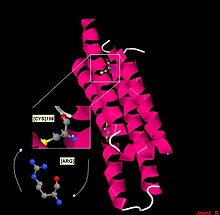Familial dysbetalipoproteinemia
| Familial dysbetalipoproteinemia | |
|---|---|
| Other names | Remnant hyperlipidemia, Remnant hyperlipoproteinaemia, Broad beta disease[1] and Remnant removal disease[1] |
 | |
| Familial dysbetalipoproteinemia is caused by this point mutation in ApoE | |
| Specialty | Medical genetics, endocrinology |
Familial dysbetalipoproteinemia or type III hyperlipoproteinemia is a condition characterized by increased total cholesterol and triglyceride levels, and decreased HDL levels.[2]
Signs and symptoms
Signs of familial dysbetaproteinemia include
angina pectoris or stroke in young adults or middle aged patients.[3]
Causes
This condition is more likely when a mutation in
VLDL, also known as very-low-density-lipoprotein receptor. Individuals with two copies of the ApoE2 gene have substantially elevated risk of this condition.[4][5]
This defect prevents the normal metabolism of chylomicrons, IDL and VLDL, otherwise known as remnants, and therefore leads to accumulation of cholesterol within scavenger cells (macrophages) to enhance development and acceleration of atherosclerosis.
Diagnosis
This section is empty. You can help by adding to it. (November 2017) |
Treatment
First line of management is fibrates.[citation needed]
See also
- Primary hyperlipoproteinemia
- Apolipoprotein B deficiency
- List of cutaneous conditions
References
- ^ ISBN 978-1-4160-2999-1.
- ISBN 978-0-7216-2921-6.
- ^ Genest J, Libby P. Lipoprotein disorders and cardiovascular disease. In: Bonow RO, Mann DL, Zipes DP, Libby P, eds. Braunwald's Heart Disease: A Textbook of Cardiovascular Medicine. 9th ed. Philadelphia, PA:Saunders Elsevier; 2011:chap 47.
- ^ "APOE gene".
- ^ "Apolipoprotein E and familial dysbetalipoproteinemia: clinical, biochemical, and genetic aspects".
